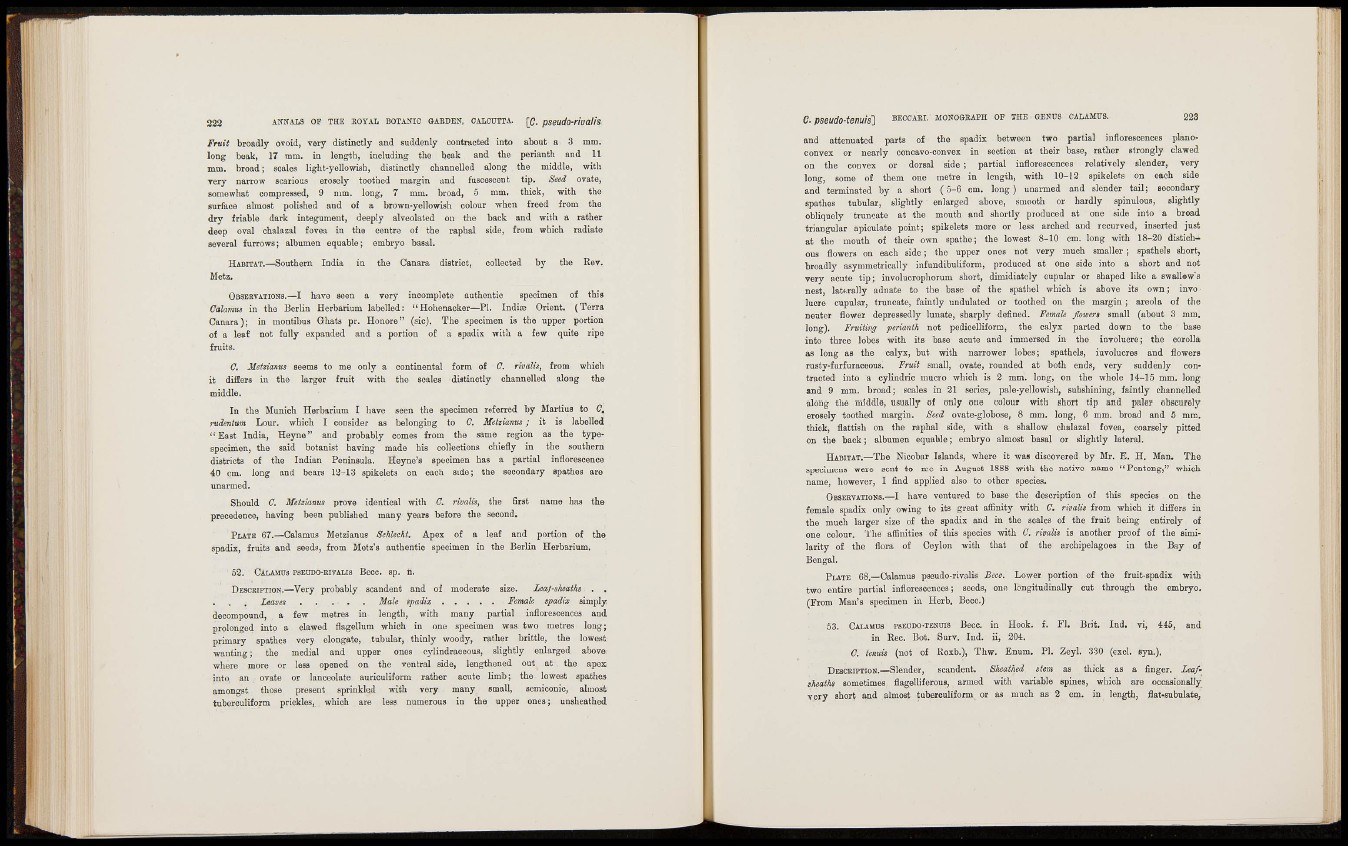
222 ANNALS OP THE EOYAL BOTANIC GARDEN, CALCUTTA [C. pseudO-HuallS
Fruit broadly ovoid, very distinctly and suddenly contracted into about a 3 mm.
long beak, 17 ram. ia length, including the beak and the perianth and 11
mm. broad; scales light-yellowish, distinctly channelled along the middle, -with
Tery narrow scarious erosely toothed margin and fuscescent tip. Seed ovate,
somewhat compressed, 9 mm. long, 7 mm. broad, 5 mm. thick, with the
surface almost polished and of a brown-yellowish colour when freed from the
dry friable dark integument, deeply alveolated on the back and with a rather
deep oval chalazal fovea in the centre of the raphal side, from -which radiate
several furrows; albumen equable; embryo basal.
HáBrTAT.—Southern India ia the Cañara district, collected by the Rev.
Metz.
OBSERVATIONS.—I have seen a very incomplete authentic specimen of this
Calamus in the Berlin Herbarium labelled: "Hohenacker—PI. Indi® Orient. (Terra
Cañara); in montibus Ghats pr. Honore" (sic). The specimen is the upper portion
of a leaf not fully expanded and a portion of a spadix with a few quite ripe
fruits.
C. Metzianus seems to me only a continental form of 0. rivalis, from which
it diSers in the larger fruit with the scales distinctly channelled along the
middle.
In the Munich Herbarium I have seen the specimen referred by Martiua to Q,
rudentum Lour, which I consider as belonging to C. Metzianus; it is labelled
" East India, Heyne" and probably comes from the same region as the typespecimen,
the said botanist having made his collections chiefly in the southern
districts of the Indian Peninsula. Heyne's specimen has a partial inflorescence
40 cm. long and bears 12-13 spikeleta on each side; the secondary spathes are
unarmed.
Should G. MeUianus prove identical with C. rivalis, the first name has the
precedence, having been published many years before the second.
PlATK 67.—Calamus Metzianue Schlecht. Apex of a leaf and portion of the
spadix, fruits and seeda, from Metz's authentic specimen in the Berlin Herbarium.
52. CALAMUS PSEÜDO-SIVALIS Becc. sp. n.
DESCEIPTION.—Very probably scandent and of moderate size. Leaf •sheaths . .
Leaves M.aU spadiz Female spadix simply
decompound, a few metres in length, with many partial inflorescences and
prolonged into a clawed flagellum which in one specimen wa.s two metres long;
primary spathes very elongate, tubular, thinly woody, rather brittle, tlie lowest
wanting; the medial and upper ones cylindraceous, slightly enlarged above
where more or less opened on the ventral side, lengthened out at the apex
into an ovate or lanceolate auriculiform rather acute limb; the lowest spathes
amongst those present sprinkled with very many small, semiconic, almost
tuberculiform prickles, which are less numerous in the upper ones; unsheathed
C. pseudo-temis] BECCAEI. MONOGEAPH OF THE GENUS CALAMUS. 223
and attenuated parts of the spadix between two partial inflorescences planoconvex
or nearly concavo-convex in section at their base, rather strongly clawed
on the convex or dorsal side ; partial inflorescences relatively slender, very
long, some of them one metro in length, with 10-12 spikelets on each side
and terminated by a short ( 5 - 6 cm. long) unarmed and slender tail; secondary
spathes tubular, slightly • enlarged above, smooth or hardly spinulous, slightly
obliquely truncate at the mouth and shortly produced at one side into a broad
triangular apiculate point; spikfileta more or less arched and recurved, inserted just
at the mouth of their own spathe; the lowest 8-10 em. long with 18-20 distichous
flowers on each side; the upper ones not very much smaller ; spathels short,
broadly asymmetrically infundibuliform, produced at one side into a short and not
very acute tip; involucrophorum short, dimidiately cupular or shaped like a swalkw's
nest, laterally adnate to the base of the epathel which is above its own; involucre
cupular, truncate, faintly undulated or toothed on the margin ; areola of the
neuter flower depressedly lunate, sharply defined. Female floweri small (about 3 mm.
long). Fruiting perianth not pedicelliform, the calyx parted down to the base
into three lobes with its base acute and immersed in the involucre; the corolla
as long as the calyx, but with narrower lobes; spathels, involucres and flowers
rusty-furfuraceous. Fruit small, ovate, rounded at both ends, very suddenly contracted
into a cylindric mucro which is 2 mm. long, on the whole 14-15 mm. long
and 9 mm. broad; scales in 21 series, pale-yellowish, subshining, faintly channelled
along the middle, usually of only one colour with short tip and paler obscurely
erosely toothed margin. Seed ovate-globose, 8 mm. long, 6 mm. broad and 5 mm.
thick, flattish on the raphal side, with a shallow chalazal fovea, coarsely pitted
on the back; albumen equable; embryo almost basal or slightly lateral.
HABITAT.—The Nicobar Islands, where it was discovered by Mr. E. H. Man. The
specimens were sent to n;e in August 1888 with the native name "Pentong," which,
name, however, I find applied also to other species.
OBSERVATIONS.—I have ventured to base the description of this species on the
female spadix only owing to its great affinity with C. rivalis from which it differs in
the much larger size of the spadix and in the scales of the fruit being entirely of
one colour. The affinities of this species with C. rivalis is another proof of the similarity
of the flora of Ceylon with that of the archipelagoes in the Bay of
PLATE 68.—Calamus pseudo-rivalis Becc. Lower portion of the fruit-spadix witi
two entire partial inflorescences; seeds, one longitudinally cut through the embryo.
(From Man's specimen in Herb, Becc.)
53. CALAMUS PSEUDO-TENUIS Becc. in Hook. f. Fl. Brit. Ind. vi, 445, and
in Rec. Bot. Surv. Ind. ii, 204.
C. tenuis (not of Koxb.), TIiw. Enum. PI. Zeyl. 330 (excl. syn.).
DESCRIPTION.—Slender, scandent. Sheathed stem as thick as a finger. Leafsheaths
sometimes flagelliferouB, armed with variable spines, which are occasionally
v e r y short and almost tuberculiform or as much as 2 cm. in length, flat-subulate,